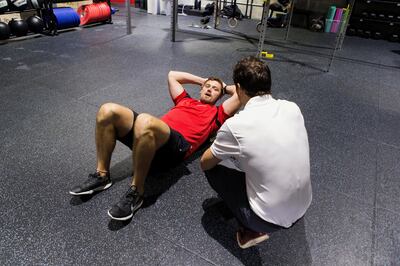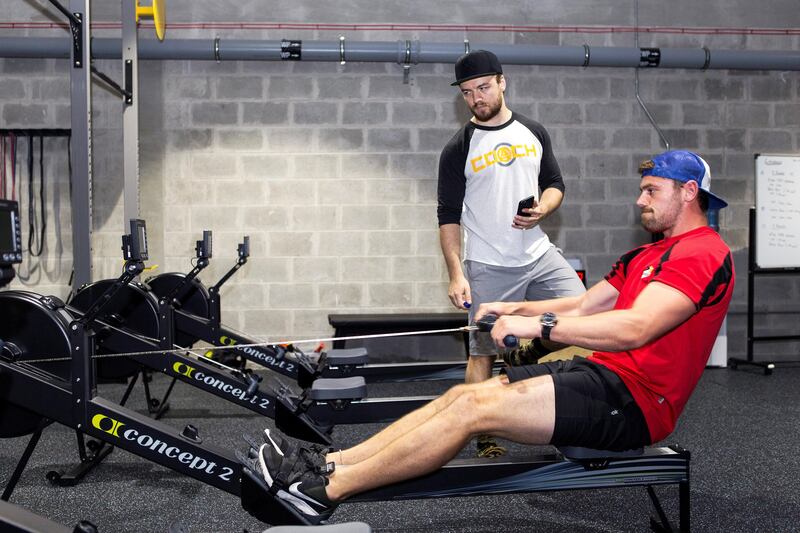A leading figure in UAE rugby is set to revive his pursuit of a first international cap, having missed almost all of last season because of brain bleed.
Steve Hamilton, the Abu Dhabi Saracens centre, will defy some medical advice, as well as concerns voiced by his family, when he starts playing again, with the season starting next month.
The 29-year-old Englishman is confident he has deciphered broadly contrasting doctors’ assessments of his condition, which even saw him be prescribed a lifetime on anti-epilepsy medication, to inform his decision to play on.
Hamilton, who dovetails playing duties with his role as director of rugby at Saracens, will be eligible for selection for UAE this season.
He says the prospect of playing Test rugby is fuelling his desire to return to the field.
“That is the main driver,” Hamilton said. “I really want to achieve that. I was lucky enough to get England Counties caps when I was a youngster, so I thought it would be a good balance to have a UAE national cap next to that.
“I definitely want to put myself in that position. Also, I want to support Saracens. Ultimately, they were the reason I came out here.
“The club has been through some real highs, and now it is going through a transition time. I want to be a part of it.
“I still have things I can achieve in my career. I don’t think it is coming to an end just yet.”
______________________________
NUMBERS
1.94 – Amount of head injuries on average per 1,000 tackles, according to World Rugby research
2.6 – A tackler is 2.6 times more likely to suffer a head injury than the player being tackled
5 – Representatives from five sports - rugby union, rugby league, American football, ice hockey, and Australian rules - met in Dublin in March to work out a unified approach to tackling concussion
25 – Per cent of match-day injuries are concussion, according to an English Premiership rugby study
76 – Per cent of head injuries happen via a tackle – as opposed to scrum, ruck, lineout, etc – according to World Rugby data
______________________________
The long road to a return stems back almost a year, to when he suffered a head injury in Saracens’ season opening match against Al Ain Amblers.
Swelling on one side of his head was one visible symptom, while his behaviour also suggested significant damage might have been done.
“There were definitely some symptoms after that game of concussion,” he said.
“My reaction to it was that I was really emotional, crying. I was trying to speak. All I wanted to say in my head was that I am fine, but I couldn’t.
“I was choked, and I couldn’t vocalise what I wanted to do. Simon [Case], the physio, was saying he wasn’t quite sure what I was trying to do, but this was obviously out of character.”
He sat out subsequent fixtures, and when he did return to training as light as cycling a stationary bike, he suffered dizziness and headaches.
The club’s medical staff, led by Tim Fletcher, a former UAE player who is now a physio and qualified medical educator with specific knowledge of concussion treatment, closely monitored his return to health.
MORE ON UAE RUGBY:
- Dubai Wasps forced to pull out of UAE's domestic rugby by spiralling costs
- DSC Eagles admission to UAE Premiership faces heavy criticism from city rivals
- Al Ghazal's closure throws future of Abu Dhabi Saracens into doubt
“I got through that, everything was OK, then a week or so later, I woke up in the middle of the night thinking I could hear noises in the living room,” Hamilton said.
“I got up, then dropped, landed on the side of the bed, fell down and suffered a seizure, for no longer than 10 seconds.
“I can’t remember falling, but I can remember being on the floor, so I might have only blacked out for a couple of seconds.
“I had a really weird reaction where, as soon as it had stopped, I started laughing.
“I could hear my wife [Shona] asking what was going on, I could feel my body shaking. Then I came round and started giggling and laughing, saying: ‘Oh, that was a bit weird’.
“I started walking round the living room trying to work out what the noise was, and didn’t consider the fact I’d just had a seizure, then got back into bed and fell asleep.
“I didn’t think anything of it, while my wife spent the night checking my breathing, crying her eyes out, not understanding what had just happened.”
He spoke to Fletcher about the seizure, then a doctor, and finally a neurologist. An MRI scan identified bleeding on the back left side of his brain.
“If he hadn’t have done that, and left it for the week, who knows what might have happened,” Fletcher said.
Hamilton sought a variety of different medical opinions, and was given a range of diagnoses.
One prescribed medication that treats epilepsy, advice he overlooked after discussions with specialists in brain injuries based in the UK.

With rugby still a relatively niche sport in the UAE, he was frustrated by a lack of knowledge of the impacts a player suffers in the sport.
“Because the doctors don’t know the sport, as far as they’re concerned, it is a stupid thing to be doing anyway,” he said.
“I had to show YouTube clips of what had happened. It wasn’t helped by the fact Shona had also played that weekend and had a black eye. He was like, ‘What are you guys doing?’
“I feel like there was a weakness in my body at the time, I have had low blood pressure as well, so I can be objective about it.”
Follow up scans two months later revealed the bleeding had stopped.
Hamilton pooled all the information he had been given (as well as adopting a unique method of testing it himself: “I have had a few big wipe-outs wakeboarding, which have tested my head, and have had no concussions”) before opting to play on.
“It is a major injury,” Fletcher said. “These blood vessels supply certain areas of the brain, and a haemorrhage in one of those areas can cause death.
“In other areas, if the bleed has stopped, you can get back to sport and back to normal.
“That is a call I couldn’t make as a physiotherapist. It is down to a neurologist or highly trained doctor.
“If Steve has had that information, that is his call. I think there is a lot of emotion to that after what he has been through, but I wish him the best.”
READ ALSO:
- Abu Dhabi big enough for three clubs, says Saracens director
- What sponsors get out of being involved with clubs across Emirates
- Teams compete for titles on the pitch as they chase dirhams off it
So will a return to the playing field hold any sense of trepidation for the player himself?
“No, it doesn’t concern me,” Hamilton said. “I am confident in feeling as I do. It is definitely a concern for family. My wife, if she had her way, would probably prefer I did not return to rugby at all.
“When I am ready to give it up, I will give it up. If something severe happens that has an effect on me or my family, the dynamic changes, but that question is not out there at the moment.”






